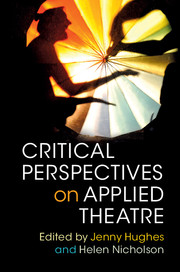Book contents
- Frontmatter
- Contents
- List of figures
- List of contributors
- 1 Applied theatre: ecology of practices
- PART I HISTORIES AND CULTURAL MEMORIES
- PART II PLACE, COMMUNITY AND ENVIRONMENT
- PART III POETICS AND PARTICIPATION
- 10 Applied theatre and participation in the ‘new’ South Africa: a possible politics
- 11 Staging Labour Rights
- 12 The micro-political and the socio-structural in applied theatre with homeless youth
- 13 A good day out: applied theatre, relationality and participation
- Notes
- Index
- References
12 - The micro-political and the socio-structural in applied theatre with homeless youth
from PART III - POETICS AND PARTICIPATION
Published online by Cambridge University Press: 05 April 2016
- Frontmatter
- Contents
- List of figures
- List of contributors
- 1 Applied theatre: ecology of practices
- PART I HISTORIES AND CULTURAL MEMORIES
- PART II PLACE, COMMUNITY AND ENVIRONMENT
- PART III POETICS AND PARTICIPATION
- 10 Applied theatre and participation in the ‘new’ South Africa: a possible politics
- 11 Staging Labour Rights
- 12 The micro-political and the socio-structural in applied theatre with homeless youth
- 13 A good day out: applied theatre, relationality and participation
- Notes
- Index
- References
Summary
Applied theatre projects often find themselves caught between individual versus community interests and micro-political interventions versus socio-structural analyses. The ethical and creative trials of applied theatre projects can become most pronounced when practitioners and researchers carry out their work within particular communities, in full view of the tensions inherent in attending to the micro- and macro-political meanings and possibilities of their work. In this chapter, I explore some applied theatre research from a shelter for homeless youth in Toronto (Canada) in which these points of tension were particularly evident. Socio-economic inequality and socio-spatial polarization are realities in many global Western cities. Our interdisciplinary research (including scholarly, community, national, governmental, and non-governmental organizations) is focused on urban inequality and socio-spatial (i.e., neighbourhood) polarization in six Canadian metropolitan areas: Vancouver, Calgary, Winnipeg, Toronto, Montréal, and Halifax. Applied theatre, I argued to the larger cross-disciplinary team, would be both a fitting research methodology and form of socio-artistic engagement to get inside the locality of such macro socio-economic processes and structures. As the interdisciplinary team considered the growing socio-spatial inequality in Toronto, I felt motivated to make a contribution to the larger project in three distinct ways. First, I wished to strongly inject youth voices into the larger study, and conceivably some of the most marginalized youth voices there are: shelter or homeless youth. Second, I wanted to bring a drama methodology to this mixed methods study for its potential to differently discover and articulate qualitative stories, as well as engage in knowledge mobilization practices that draw from theatre's capacity to communicate variability and nuance. Third, I wanted to work closely with specific community partners (a theatre company and a youth shelter) to benefit from our very different experiences with, and understandings of, young people.
In exploratory discussions with Project: Humanity co-founding member Daniel Chapman, we decided to work with Seeking Shelter, a shelter for homeless youth with whom they had a six-year history of work, offering free programming to their residents. This commitment is something Project: Humanity engages in as part of their mandate to make socially engaged theatre and to be responsive to their local community. Working with Project: Humanity, we used drama techniques to explore issues and experiences of spatialized inequality in young people's neighbourhoods. Methodologically, drama would be employed as a means for the youth to give creative expression to their neighbourhood and the negative attributes of localized poverty.
- Type
- Chapter
- Information
- Critical Perspectives on Applied Theatre , pp. 229 - 247Publisher: Cambridge University PressPrint publication year: 2016
References
- 7
- Cited by



